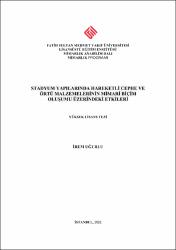Stadyum Yapılarında Hareketli Cephe ve Örtü Malzemelerinin Mimari Biçim Oluşumu Üzerindeki Etkileri
Citation
UĞURLU, İrem, Stadyum Yapılarında Hareketli Cephe ve Örtü Malzemelerinin Mimari Biçim Oluşumu Üzerindeki Etkileri, Fatih Sultan Mehmet Vakıf Üniversitesi Lisansüstü Eğitim Enstitüsü Mimarlık Anabilim Dalı Mimarlık Programı, Yayımlanmamış Yüksek Lisans Tezi, İstanbul 2021.Abstract
Stadyum yapıları, tarihsel süreçte kökeni eskiye dayanan yapılardır. Tarihte kent planlamasında önemli bir yere sahip olan stadyum yapıları, günümüzde de kapsamlı bir alana sahiptir. Kentlerin oluşmasında ve şekillenmesinde barınma, çalışma mekanları, sosyal alanlar ve yeşil alanlar kadar stadyum yapıları da etkili olmaktadır. Sadece spor mekanları olmaktan çıkıp, çok işlevli mekanlar olmasının yanı sıra bir kenti simgelen ve kentte ikon haline gelen yapılara dönüşmektedir.
Günümüzde stadyum yapılarının sayısının artması ile birlikte farklı form ve biçim arayışları da artmaktadır. Gelişen teknoloji sayesinde yeni malzemeler ve yeni sistemler doğrultusunda, hareketli yapı tasarımları hayata geçirilmektedir. Stadyum yapısının örtü sistemlerinde, cephe tasarımlarında, tribün ve saha alanlarındaki hareket çeşitlilikleri, tasarımda biçimsel farklılıkları oluşturmaktadır. Stadyum yapısının iç ve dış mekanlarında meydana gelen hareket, yapının estetik, konfor, işlev ve fonksiyon açısından kullanılabilirliğini etkilemektedir.
Bu bağlamda hazırlanan tez çalışmasında malzeme ve hareket kavramlarının biçim oluşumu üzerindeki etkileri araştırılmış ve yapı, işlevsel esneklik, dönüştürülebilirlik, büyüyüp/küçülme, uyarlanabilirlik, modülerlik gibi kavramlarla yorumlanmıştır. Yedi bölümden oluşan tez çalışmasında birinci bölümünde çalışmanın amacı, kapsamı ve yöntemi açıklanmıştır. İkinci bölümde, stadyum yapılarının tarihsel gelişiminden bahsedilmiş, Antik çağ, 19., 20. ve 21. Yüzyıl dönemlerine ayrılan tarihsel süreçten sonra stadyum türleri açıklanmıştır.
Tezin üçüncü bölümünde, yapılarda hareket kavramının tarihsel sürecinden bahsedilmiştir. Stadyum yapılarının tarihsel süreçteki mimari özellikleri, gelişimleri ve kullanılan hareket türleri incelenmiştir. Hareketli cephelerin ve hareketli örtü sistemlerin kullanım amaçları ve özellikleri belirtilmiştir.
Tezin dördüncü bölümünde, malzeme kavramı ve stadyum yapılarında kullanılan malzeme çeşitleri incelenmiştir. Beşinci bölümde, hareket ve malzeme davranışlarının biçimsel oluşumu üzerindeki etkileri araştırılmıştır. Altıncı bölümde ise dünyadan verilen stadyum tasarımı örnekleri incelenmiş ve hareket sayesinde oluşan biçimsel değişimler ortaya konulmuştur.
Tezin son bölümü olan yedinci bölümde; incelenen konular ve örnekler ile ilgili sonuç ve değerlendirmeler anlatılmıştır. Stadium structures are structures whose origins date back to the past in the historical process. Stadium structures, which have an important place in urban planning in history, have a comprehensive area today. Stadiums, as well as accommodation, working spaces, social areas and green spaces, are effective in the formation and shaping of cities. It is not only sports venues, but also multifunctional venues, as well as transforming into buildings that symbolize a city and become an icon in the city.
Nowadays, with the increase in the number of stadium structures, the search for different forms and forms is also increasing. Thanks to the developing technology, moving building designs are implemented in line with new materials and new systems. The variations of movement in the covering systems of the stadium structure, facade designs, grandstand and field areas create formal differences in design. The movement that occurs inside and outside of the stadium structure affects the usability of the building in terms of aesthetics, comfort, function and function.
In this thesis prepared in this context, the effects of the concepts of material and motion on form formation were investigated and interpreted with concepts such as structure, functional flexibility, transformability, grow / shrink, adaptability, and modularity. In the first part of the thesis, which consists of seven parts, the aim, scope and method of the study are explained. In the second part, the historical development of the stadium structures is mentioned, and the types of stadiums are explained after the historical process divided into Antiquity, 19th, 20th and 21st Centuries.
In the third part of the thesis, the historical process of the concept of movement in structures is mentioned. The architectural features, developments and movement types of the stadium structures in the historical process were examined. The usage purposes and properties of moving facades and moving curtain systems are specified.
In the fourth part of the thesis, the concept of materials and the types of materials used in stadium structures are examined. In the fifth chapter, the effects of movement and material behavior on the formal formation are investigated. In the sixth chapter, stadium design examples given from the world are examined and the formal changes caused by the movement are presented.
In the seventh part, which is the last part of the thesis; results and evaluations related to the studied subjects and examples are explained.



















